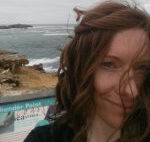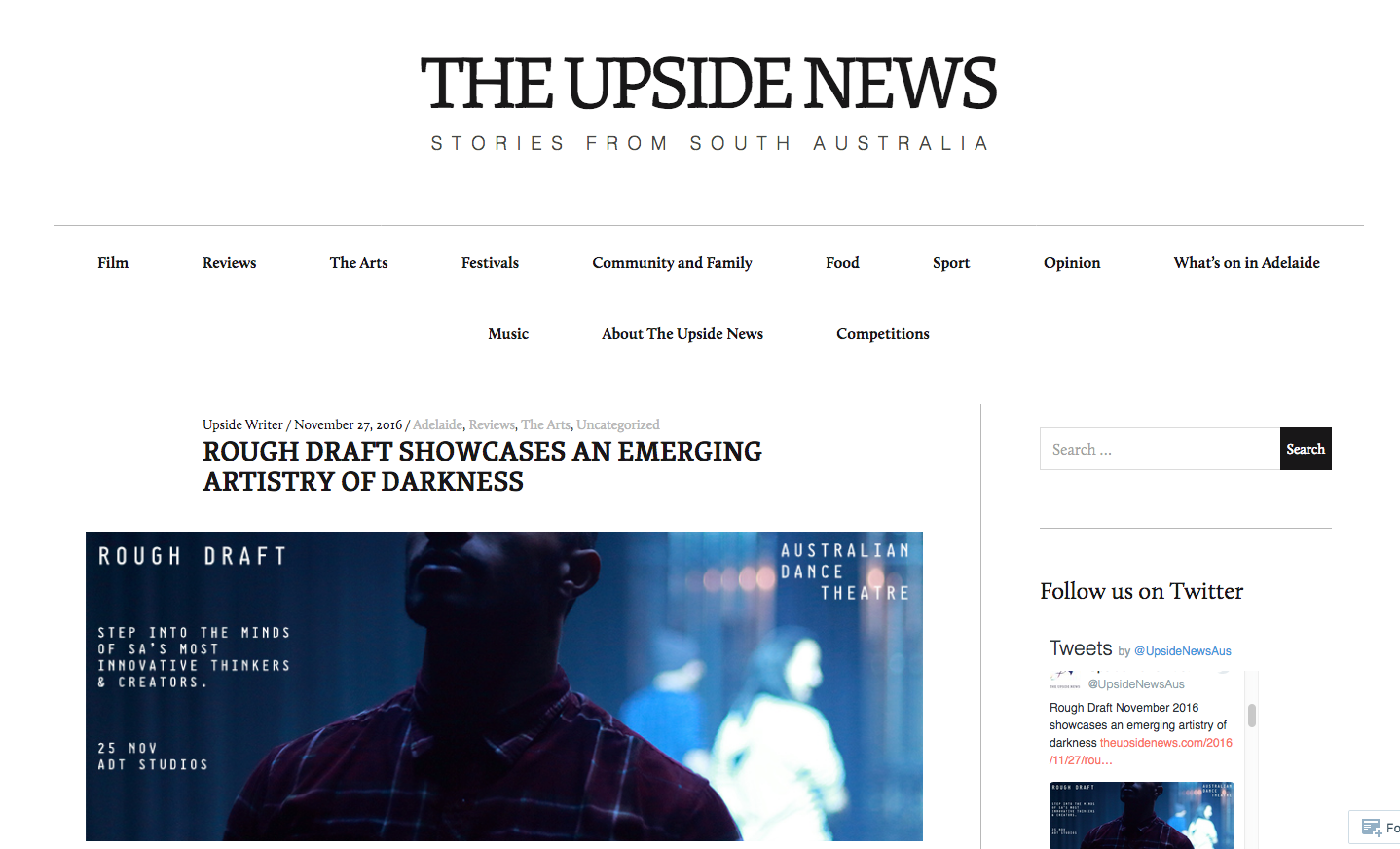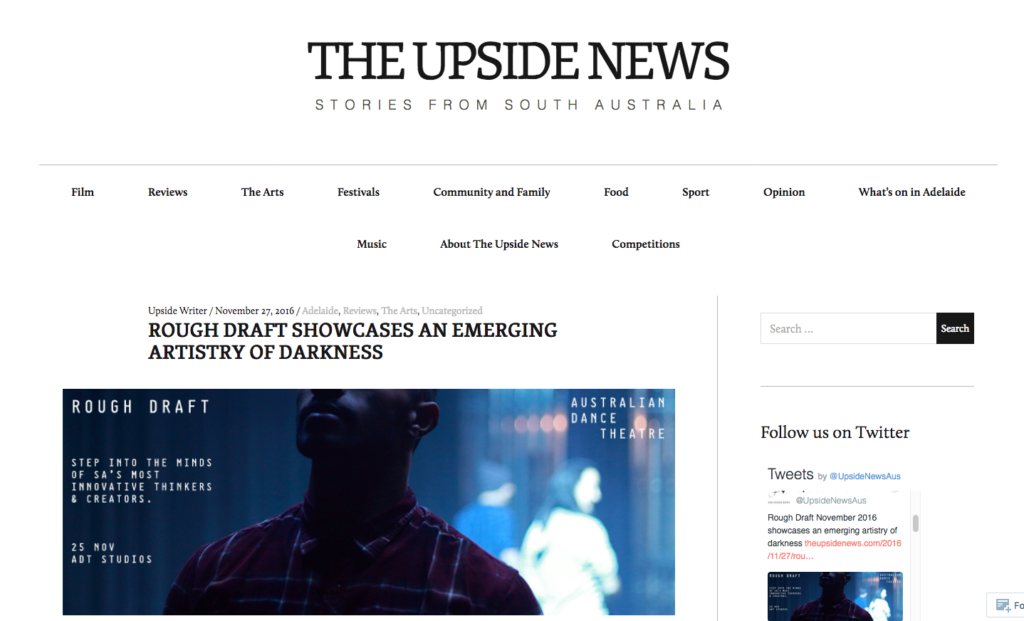Rough Draft is Australian Dance Theatre’s regular, donation-entry-only event, which showcases the works-in-progress of talented local choreographers. The latest Rough Draft was held on 25 November 2016. What it showed us is that the most powerful works being developed locally are coming from a very dark place, shining a light on the parts of ourselves that we habitually ignore in our quest for mindless, sugary happiness.
ROUGH DRAFT SHOWCASES AN EMERGING ARTISTRY OF DARKNESS
This review was first published at The Upside News on 27 November 2016. Click here to see it.
This season of Rough Draft brought us the rough drafts of new works by six talented local choreographers. But it was the ADT dancers themselves whose work stood apart.
Australian Dance Theatre’s Rough Draft is the kind of event where you walk in and feel like a youngster even in your mid-to-late thirties. It’s the kind of random-feeling arts event where you see behind the shiny polish and into the hearts and minds of emerging choreographic artists and, sometimes, emerging dance artists.
Given the event was scheduled to start relatively early on a Friday, I didn’t bother getting changed out of my corporate nine-to-five. People still dress up to go and see dance performances, even in 2016, and even when it’s at your local dance company’s studios. Which, let’s be honest, is what Australian Dance Theatre is for me: I’m a fixture of their adult dance school. To me it’s the local dance company; to you it’s one of the best contemporary dance companies in the world.
Standing around doing my best to look quite comfortable keeping company with the large succulent in the foyer, drinking what seemed like an oversized, fluorescent can of Sprite among the older, wine-drinking crowd, I had a running narrative in my mind. Only two people that I knew – besides ADT’s producer Eire – were there: Areti, the stunning Flamenco dancer who is the Australian Ballet School’s Spanish dance teacher and founder of local school Flamenco Areti; and Janet Bridgman, ADT’s resident pilates trainer and former professional dancer herself.
As more people filed in, and drank and spilled the wine, I found myself torn between tuning into other people’s conversations and simply tuning out into my own world. In front of me was a group of people gasping about someone else’s bad news. To my left was a florid man who, excited about the thimble-full of wine he held, had accidentally slopped some on the floor. To my right a lost-looking fellow, who may have been fabulous conversation, but after the day I’d had, the last thing I wanted to do was hustle up and talk to a stranger. Maybe it was a missed opportunity; it’s pretty good odds that conversation would have been intelligent.
Running a bit late from the city, friends turned up close enough to opening time that they didn’t endure this kind of battle like I did; yet early enough to get excited about the wine themselves. We were the fashionably late kids who got into the studio and realised we were too short to sit in the chairs at the back as well as see, so we ended up walking in front of people and all but cuddled up to the front-row-floor-sitters.
It was at about this time that I regretted not getting changed. Corporate dresses have very little give, and getting familiar with the floor is difficult if one wishes to retain one’s, er, shall we say, _dignity_.
But, sit we did.
Unlike the previous Rough Draft seasons I’d been privy to, this one felt like it was filled with talking. Much of it, including the short commentary by artists on their works, is necessary and, most of the time, enlightening. But discussion pieces felt out of place, particularly given the looooong time to drink. Why not talk to us while we drink and are receptive, rather than trying to keep blood flow to our bums and legs on the floor? It would have made more sense.
Perhaps that’s something ADT could do better next time.
The opening talk by Jeff Meiners of UniSA, which was ostensibly to be a discussion piece about Panpapanpalya, the 2018 International Congress of Dance that is being held here in Adelaide, was less about how dance can transform society, and far more about begging for help. I have come to expect this from the Arts, because much of the communication one gets as an arts supporter comes down to two things: ‘Please give us money’, ‘please like what I do’. This despite the fact that if you’re an artist, or you work in the arts, the one thing you can’t afford to be is a beggar. Nobody respects a beggar.
As a businesswoman, I found the presentation frankly annoying. Did we really need to hear about the fact that they’re writing budgets? Perhaps it’s just me, but if you are hosting an international, week-long conference and you don’t have a budget, then I would consider that you’re not doing your job properly. Your daily grind isn’t something you need to present to a public crowd.
Once that was out of the way, we were treated to the first choreography of the evening. Former ADT dancer Lina Limosani had thrown together a piece in a short period of time with the Adelaide College of the Arts’ second year dance students. Her brief introduction about the process highlighted the unseen struggle of new creative works of all kinds: Realisation that things imagined can’t work as things real; fear of being a cheat; attachment to the darlings that you know you have to kill but are not willing to.
The piece itself was slurpy and dark, sketching out an emergence from primal ooze. It made me think of swamp beasts in another realm. Pulled out of a mud pool and brought to life, each creature struggled to know where it was and what it was becoming. As time passed, it grew, grew in realisation, panicked, and suffocated.
The dancers had thrown themselves into the theatricality of the work. Limosani had worked with them in a way designed to encourage their emergence as eccentric movement artists. They were focused and coherent, and it was strong… long enough to make you uncomfortable. It will be interesting to see where this work ends up; Limosani is a mature choreographer and her works are always extremely high calibre pieces.
The second piece was by ADT dancer, Kimball Wong. A fun, lighthearted work, Exercises on Six was pretty much a whole lot of cascading movement to counts of six. It was simply a work in movement through six counts. Performed by ADT dancers who clearly enjoyed every moment of it, Exercises on Six was kind of like a glassed-in room filled with coloured balls and joyful children. As an observer, you’re on the outside wishing you could join in this kind of fun, too, dammit.
Exercises on Six ended up being my companions’ favourite work of the evening. It wasn’t my favourite but it ranked a super close third place.
Then, time for more talking. Gabrielle Nankivell talked about her forthcoming work Split Second Heroes, which has been in production for four years or more. She covered the history of that production right from its earliest days, through to her collaboration with ADT earlier this year, and what it’s been like moving into choreographic development. Nankivell is a confident speaker, but as she got closer to the end, her body language changed. By the time she’d finished talking, she had closed herself right off, from her feet upwards: Legs crossed, arms across her belly. She was clearly feeling vulnerable about this work, nervous about its opening next year. Nankivell’s work opens in mid-2017 as part of the Festival Theatre’s 2017 program.
The dancer whose choreography I’d been wanting to see followed Nankivell. Thomas Fonua was this year nominated for an Adelaide Critics Circle Emerging Artist Award for his work Malaga, parts of which he’d shown the last Rough Draft. Fonua explores his Samoan heritage, and while this makes me sound like a comfortable, middle-aged white woman in a first world country, the islander sensibility of his art is what sets Fonua apart from every other choreographer in the program. Fonua might be a contemporary artist, but he is first and foremost an indigenous contemporary artist, and long may his fearlessness in this genre be a credit to him.
Fonua’s piece, …Speak of the Devil, is an excerpt from an exploration of the nature of ritual. The exploration is of dark spirits, superstition, and the ‘significance of ritualism in Samoa, pre- and post-colonization’.
Unlike Malaga, which was a deeply emotional construction, …Speak of the Devil is a much more academic examination of ritual: Less personal and, to that end, less emotional. It also tends to follow a recognised shape in terms of contemporary choreography, from the performance to the narrative. It’s like a formula that is pretty hard to get wrong, and audiences love it when dancers are given the opportunity to ad lib. I’m assuming the boys at the end were drawing on their own experiences; if they weren’t, and that was scripted, please let me know! I would stand corrected.
After his performance, Tom talked to us a bit about what Rough Draft’s intentions are, and what he gains from the practice as an emerging artist. He focused heavily on the notion of leadership, and how in his own life as an artist and an emerging choreographer, the notion and role of leadership is both formative and creative. He spoke at length about the need for great leadership skills and that this is, in fact, what you gain from Rough Draft as an artist who is also a choreographer.
I whispered to my friend, who works in the Arts, that the entire industry needs to level up its leadership. She agreed. The problem is, the arts are also fairly navel-gazing and business acumen paired with good leadership is difficult to come by. As Tom pointed out, Australian Dance Theatre is lucky to have great leaders, great demonstrations of leadership, and an internal hierarchy that is fluid and supportive of leadership development.
Carrie Angel followed Tom with Phrenic, a piece about chronic disease. During the interval, the artists had put pencils and bingo sheets on everyone’s chairs. This is because Phrenic starts with Chronic Disease Bingo, an interactive and engaging session. All of the numbers come attached with commentary about chronic disease from self and others. Things like, ‘You’re only sick because you’re negative’; ‘Number 30, feeling dirty’, etc. Following the Bingo session, Carrie performed suspended in a series of ropes, in a physical representation of struggle and difficulty while listening to a meditation.
While the conception of Phrenic was excellent, its writing was good and the physical performance was admirable, the piece actually left me cold. It was far too long for me. The twisting suspension, which was necessarily repetitive given the nature of what it represented, doused the enthusiasm and engagement that began with the bingo session and that was helped along by the sharp writing. Its open-endedness, which may also have been intentional, just felt unfinished and unconcluded. It’s nice work, but I didn’t feel the soul in it. Competence in suspension performance isn’t the same as art.
Repetition was also a theme of Felix Sampson’s piece titled Creative Development. In this Creative Development, we witness the development of a song. The intense frustration, searching, scribbling; flashes of insight to flashes of disappointment; getting stuck on sections and not being able to move forwards with them; right through to the almost-final shape. It turns out that Felix has an amazing voice. It was as much a part of the instrumentation of this work as his facial expressions and physical control. I found myself wondering where this creation stopped and Felix began, and perhaps that was the point.
As a writer, I found myself in Felix’s work. The inspiration to disappointment cycle, and the desire to create bouncing off a wall of disillusion was so familiar to me. I wonder, if someone is not creative how would they perceive this? Maybe someone who was there can enlighten me.
And finally, Matte Roffe presented Cottontail right at the end of the evening. Having seen Wolff at ADT’s Ignition earlier in the year, I was dying to see Matte’s work again. Like Thomas Fonua, Matte Roffe creates works that are soular experiences. The play from absurdly happy to intense darkness in this work was beautifully handled. As an observer, I feel like such works open us up to difficult conversations with the darkest sides of ourselves, and it turns out that it makes people uncomfortable. Reference my aforementioned friends who prefer lighthearted happy to the darkness of the soul.
Roffe’s Cottontail is described as ‘being inspired by Peter Rabbit and Friends, The Velveteen Rabbit, and cosmetic testing on animals’. Really though the inspiration is representation. The bouncing happiness of Peter Rabbit and Friends bookends the work; the floppy, wishing-he-was-real Velveteen Rabbit was dragged offstage at the end; and the dark torture in the middle of the work couldn’t be from anywhere else but cosmetic testing. Roffe’s work is highly physical, and this performance showcased his and Kimball Wong’s strength, control, tumbling, and falls.
Cottontail was arguably the most mature work of this season of Rough Draft, and certainly the most complete. While some of the other works may have been in production for longer, length of production is not an indication of the capacity of a choreographer. As a choreographer, Roffe has an ironic, camp, almost sarcastic, whimsy; a quality that is missing from the creations of every other piece, and it’s this that marks his maturity as an artist.
But that could just be me; as an observer and consumer of art, I find fun is fun but darkness shifts. It’s in the darker pieces of Fonua and Roffe that we are seeing an emerging artistry that denies the navel-gazing explorations of individual artists and embraces the confronting darknesses that we as a society need to embrace to solve, rather than push away and ignore.
You can read the original publication here.


